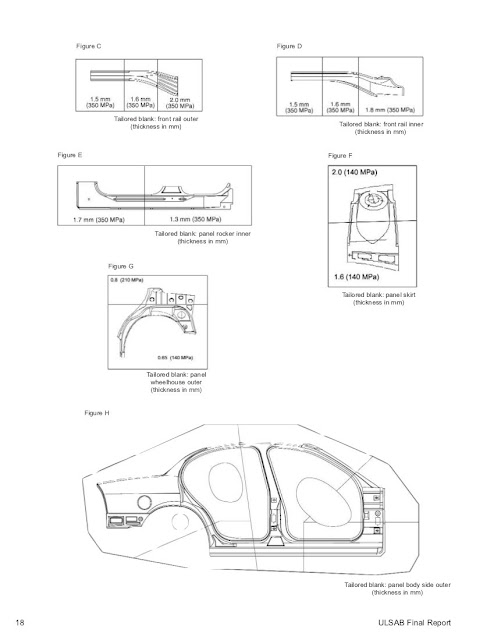Memegang body mobil2 baru atau mobil 1990-an keatas kok rasanya tipis banget. Terutama dibagian pintu dan daerah mesin. Ditekan ringan pun peyot :D . Beda dengan charade 82 saya, rasanya lebih kokoh. Konon plat body jaman sekarang memang tipis-tipis karena 3 alasan berikut :
1. Ekonomis, harga jual mobil bisa ditekan.
2. Keamanan, daerah mesin menjadi daerah crumple zone alias daerah ringsek. Sehingga bila terjadi benturan, energi tabrakan terserap meringsekkan daerah mesin dan ruang bagasi dibelakang. Tapi tidak meringsekan daerah kabin penumpang/pengendara. Ruang mesin dan ruang bagasi yang terlalu kuat malah akan menjepit penumpang/pengendara dalam kabin. Bumper dari fiber/plastik yang berisi styrofoam, mudah lubang/penyok jika menabrak. Maksudnya agar tidak membahayakan korban tabrakan, misalnya pejalan kaki.
3. Emisi dan efisiensi BBM, beban mobil yang berat membuat mobil "ngeden" dan emisinya buruk serta boros BBM. Butuh mesin berkapasitas besar dan tentunya lebih boros BBM.
Saya sudah "search" tentang standard tebal plat mobil tapi belum mendapatkannya. Tapi akhirnya mendapatkan pdf :
http://www.autosteel.org/~/media/Files/Autosteel/Programs/ULSAB/ulsab_final_report.pdf
Berdasarkan pdf diatas, kelihatannya standard tebal plat mobil berdasarkan jenis-jenis panel bodynya.
Apa sih ULSAB itu ?
http://www.autosteel.org/en/Programs/ULSAB.aspx
The UltraLight Steel Auto Body (ULSAB)
In early 1994, a consortium of 35 sheet steel producers from 18 countries set out to demonstrate a lightweight steel auto body structure that would meet a wide range of safety and performance targets. The Consortium contracted with Porsche Engineering Services, Inc. (PES) to provide engineering and manufacturing management for the ULSAB project.
In September 1995, the Consortium announced the results of the concept phase: a design of a typical mid-size sedan showing a weight savings of up to 36 percent in a steel vehicle structure, and substantially improved performance when compared to benchmarked averages in the same class - at a cost less than that required to produce a typical vehicle structure of that time.
In 1998, the Consortium presented to the world automotive industry, a complete ULSAB body-in-white, which dramatically validated the design concepts. That BIW remains as a focal point of a traveling exhibit that shows how to use high-strength steels to reduce mass in a vehicle structure that is Safe, Affordable, Fuel Efficient and Environmentally responsible (SAFE).
The ULSAB concept confirms steel's main attributes, and it explains why high-strength steel is the fastest growing light weighting material in automotive structures. Steel is inexpensive and strong. It is easy to form into complex shapes and structures, and it is highly suited for mass production of vehicles. Its proven ability to absorb energy in a crash is well known.
Jadi proyek ULSAB yang beranggotakan perusahaan-perusahaan otomotif dan baja mencoba membuat mobil yang lebih ringan tapi lebih kuat dan lebih aman. Dari uraian proyek ULSAB ini dapat diketahui ketebalan plat mobil yang ideal. Misalnya pada halaman 27 ada gambar :
Tampak plat 0.65 mm hanya 7.6 % dan plat 0.7 mm 25.1 %. Tebal plat 0.8 mm keatas adalah 64.3 %. Ini adalah mobil yang sangat ringan beratnya (ultralight). Rincian tebal tiap panel ada di gambar2 berikut :
Jadi kalau ada desas-desus "mobil x, plat bodynya 0.3 mm.." musti diperjelas, 0.3 mm di panel body yang mana?





